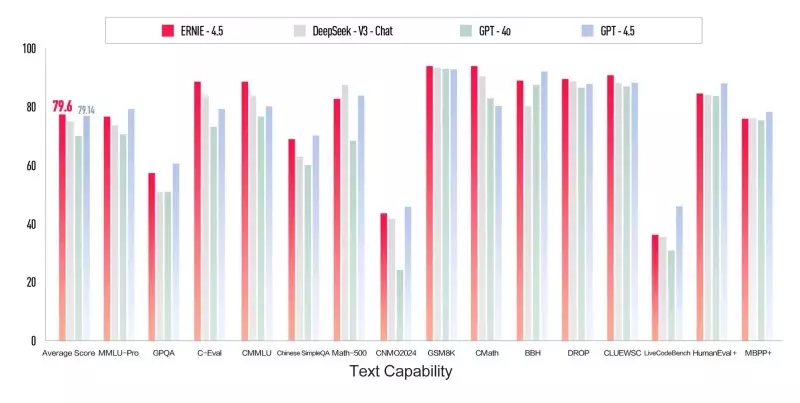In a remarkable weekend announcement, Baidu, a titan in the Chinese technology sector, unveiled two significant AI models: ERNIE 4.5, which serves as a multimodal language model, and ERNIE X1, a model tailored for advanced reasoning. These developments are not just technical upgrades; they are ambitious forays into the future of AI, showcasing Baidu’s determination to capture the competitive landscape dominated by titans like OpenAI. With bold claims of surpassing the performance of well-known models such as OpenAI’s GPT-4.5 and DeepSeek’s V3, the launch of these models represents a pivotal moment not just for Baidu, but for the AI industry as a whole.
A Glimpse into Performance Metrics
Baidu’s assertion that its ERNIE models outshine existing competitor benchmarks may stir excitement, but one must tread with caution. These models have reportedly excelled in critical evaluation metrics like C-Eval and CMMLU, which are designed to assess both linguistic understanding and reasoning capabilities in Chinese. However, the apparent success on these benchmarks hinges on how well the models translate into real-world applications. While they offer features that seem to outperform existing models, the actual usability and adaptability in various business contexts remain to be seen.
Gerard, an industry analyst, posits that “While performance metrics can paint a compelling picture, they don’t always equate to practical effectiveness, especially in dynamic environments where adaptability is key.” Baidu’s ambitious pricing strategy—significantly undercutting competitors while enhancing capabilities—also raises questions about sustainability and overall value.
Cost-Effectiveness vs. Contextual Limitations
Perhaps the most noteworthy facet of ERNIE 4.5 and ERNIE X1 is their aggressive pricing structure, claiming monumental price reductions over competitors. This positions Baidu as a cost-effective player in the crowded AI field. However, a substantial limitation lies in the reduced context window for these new models. With ERNIE 4.5 offering only 8,000 tokens compared to competitors’ astonishing 128,000-token capacity, the ability to handle complex tasks could be severely restricted.
The implications of such a constraint cannot be overlooked. As seasoned developers point out, “In the realm of in-depth conversation and complex document analysis, a shorter context window limits the model’s effectiveness. It’s akin to reading just the first chapter of a novel and trying to understand the entire plot.” This limitation could hinder the adoption of ERNIE in various sectors where extensive context is crucial.
Feature Enhancements and Unique Capabilities
Despite these limitations, the advancements that come with ERNIE 4.5 and ERNIE X1 are noteworthy. ERNIE 4.5 boasts enhancements designed to minimize hallucinations, improve logical reasoning, and even streamline coding tasks. Meanwhile, ERNIE X1 shines with its deep reasoning capabilities aimed at complex problem-solving and tool integration. From advanced searches to document-based Q&A, the model is engineered to perform a range of tasks that can significantly automate processes for enterprises.
Interestingly, these capabilities are grounded in innovative techniques like Progressive Reinforcement Learning and Heterogeneous Multimodal Mixture-of-Experts. Such advancements suggest that Baidu isn’t merely catching up to its competitors; it may be establishing a new frontier in AI technology that leverages unique methodologies.
Strategic Implications for Enterprises
For corporate decision-makers, the release of ERNIE 4.5 and ERNIE X1 brings both opportunities and considerable challenges. The attractive pricing model encourages exploration, especially for organizations considering new AI deployments. Furthermore, businesses operating within or targeting Chinese-speaking markets may find particular advantages given the model’s optimizations for Chinese language processing.
However, it’s critical for enterprises to undertake thorough evaluations before engaging with these AI models. The lack of open-source licensing for ERNIE models raises valid concerns surrounding data privacy, compliance, and integration potential, especially within regulated industries. Furthermore, the anticipated timeframe for open-source release—set for June 30, 2025—might lead some organizations to delay their engagement in favor of more established alternatives with proven track records.
The Future of Baidu’s AI Endeavors
As Baidu positions itself to lead in the multimodal and reasoning AI sectors, it is crucial to monitor how these new models evolve. There is a palpable tension between cost and performance that could redefine industry standards if adeptly managed. Baidu’s ongoing investment in AI capabilities hints at its ambition to not merely keep pace with rivals, but to redefine the benchmarks themselves.
With both ERNIE 4.5 and ERNIE X1 now available through the company’s API and the ERNIE Bot platform, the excitement around their transformative potential is palpable. As the AI race accelerates into 2025, Baidu’s latest offerings are not just technical advancements; they could mark a significant shift in how AI interacts with businesses, potentially setting a new standard against which all future models will be measured.

